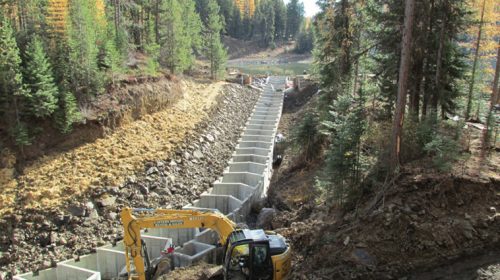Oldcastle Precast helps restore trout access to prized watershed
As La Grande Reservoir owner and operator, the City of La Grande, Ore., looked to construct a fish passage at the Upper Grande Ronde River Watershed in Union County. The structure would address seven barriers to 14-plus square miles of watershed dating to the Beaver Creek Dam construction in 1915, when contracts lacked provisions for steelhead access to spawning grounds.
The city hired Anderson Perry & Associates to design improvements to in-stream habitat and restore fish passage over existing barriers in Beaver Creek and two tributaries, through installation of a series of vortex weirs, streambed simulation material, grade control structures, boulders, and wood habitat structures. The design also included a 500-ft. vortex weir fish ladder to provide passage over the 30-ft. high dam. The project was awarded to Steve Lindley Contracting, which enlisted Oldcastle Precast Nampa to fabricate specially engineered concrete structures.
Work included completion of the required survey for various small intake sites; design drawings for improvements at all diversion locations; draft plan review with city staff; and, preparation of final documents and technical specifications to install the required improvements. In addition, Anderson Perry completed a formal Wetland Delineation Report and Biological Assessment, while securing fill and removal permits and providing agency consultation. Throughout design and construction, the project team conferred with the U.S. Forest Service, which owns the land bearing the La Grande Reservoir.
 |
| Oldcastle Precast detailed and fabricated the 70 vortex weir structures, weighing more than 10 tons each, to create an optimal, 500-ft. bypass of the 30-ft. high Beaver Creek Dam for La Grande Reservoir-bound trout and salmon. |
STEPS TO SPAWNING
The $1.4 million Beaver Creek Fish Passage Improvements project was limited to a six-month schedule, owing to water levels and weather restrictions. The remote location, 4,400-ft. elevation and short window presented many challenges: 70 precast concrete sections and a large cast-in-place inlet had to be precisely fabricated, installed and finished to ensure that the complex layout was accurate. The fish passage structure was installed with each precast unit stair stepped upon each other—abiding a radius curve and gradual grade.
“All parties involved including the contractor, engineering firm and jobsite representative, worked hard as a team to make sure the project was completed and a great success,” notes Oldcastle Precast Nampa’s Mike Blackham, P.E. “When you have a group of people willing to work together, and all have the same goal in mind, it makes the job a lot easier.”
Sources: Oldcastle Precast Nampa, Idaho; “Fish Ladder Finally Complete,” Dick Mason, The Observer, November 4, 2017 edition

